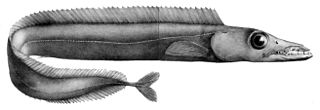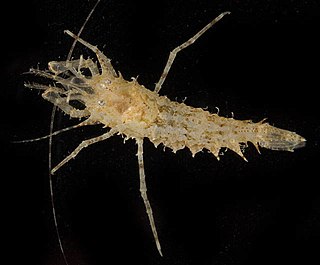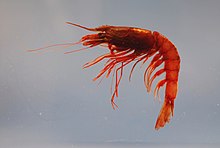
Dendrobranchiata is a suborder of decapods, commonly known as prawns. There are 540 extant species in seven families, and a fossil record extending back to the Devonian. They differ from related animals, such as Caridea and Stenopodidea, by the branching form of the gills and by the fact that they do not brood their eggs, but release them directly into the water. They may reach a length of over 330 millimetres (13 in) and a mass of 450 grams (1.0 lb), and are widely fished and farmed for human consumption.

Siphonophorae is an order within Hydrozoa, which is a class of marine organisms within the phylum Cnidaria. According to the World Register of Marine Species, the order contains 175 species described thus far.

Mirocaris is a genus of shrimp associated with hydrothermal vents. Sometimes considered the only genus of the family Mirocarididae, Mirocaris is usually placed in the broader family Alvinocarididae. Mirocaris is characterized by a dorsoventrally flattened, non-dentate rostrum, as well as the possession of episodes on the third maxilliped through to the fourth pteropod. The genus contains two species, M. fortunata and M. indica. The two species are found in different oceans, and can be distinguished by the pattern of setation on the claw of the first pereiopod.

Sepietta oweniana is a common marine mollusc from the order Sepiida, the cuttlefish.

The black scabbardfish is a bathypelagic cutlassfish of the family Trichiuridae found in the Atlantic Ocean between latitudes 69°N and 27°N at depths between 180 and 1,700 m. Its length is up to 110 cm (3.6 ft), but it reaches maturity around 80 to 85 cm.

Dromia personata, also known as the sponge crab or sleepy crab, is a species of crab found in the North Sea, the Mediterranean Sea, and connecting parts of the northeastern Atlantic Ocean. Like most other epibenthic crustaceans, the biomass of this species is especially dense in the Mediterranean continental shelf. It mainly resides from the lower shore to a depth of 50 meters (164 ft), often in caves. Occasionally, they are found living in depths as low as 110 meters (360 ft). They serve as prey for octopus, starfish, and other fish. Their last two pairs of legs are positioned dorsally, and are used to hold a sponge in place as camouflage.

Percnon gibbesi is a species of crab. It is one of at least two species commonly called Sally Lightfoot, and is also referred to as the nimble spray crab or urchin crab. It has been described as "the most invasive decapod species to enter the Mediterranean".

Polycheles typhlops is a species of blind, deep water decapod crustacean with a cosmopolitan distribution. It is "one of the dominant and most characteristic crustaceans in deep-sea communities of the Mediterranean Sea".

Eumunida picta is a species of squat lobster found in the deep sea. The species is strongly associated with reefs of Lophelia pertusa, a deep-water coral, and with methane seeps. It is abundant in the western Atlantic Ocean, where it is found from Massachusetts to Colombia.

Crustaceans may pass through a number of larval and immature stages between hatching from their eggs and reaching their adult form. Each of the stages is separated by a moult, in which the hard exoskeleton is shed to allow the animal to grow. The larvae of crustaceans often bear little resemblance to the adult, and there are still cases where it is not known what larvae will grow into what adults. This is especially true of crustaceans which live as benthic adults, more-so than where the larvae are planktonic, and thereby easily caught.
Calcinus tubularis is a species of hermit crab. It is found in the Mediterranean Sea and around islands in the Atlantic Ocean, where it lives below the intertidal zone. Its carapace, eyestalks and claws are marked with numerous red spots. C. tubularis and its sister species, C. verrilli, are the only hermit crabs known to show sexual dimorphism in shell choice, with males using normal marine gastropod shells, while females use shells of gastropods in the family Vermetidae, which are attached to rocks or other hard substrates.

Stenopus spinosus is a shrimp-like decapod crustacean belonging to the infraorder Stenopodidea.
Alpheus tricolor is a crustacean belonging to the family of snapping shrimp. It was first isolated in Indonesia and Sri Lanka. It counts with a setose carapace, an acute rostrum, shallow adrostral furrows and a basicerite with a strong ventrolateral tooth. The lamella of its scaphocerite is not reduced, with an anterior margin that is concave. Its third maxilliped counts with an epipodial plate bearing thick setae, while its first chelipeds are found with their merus bearing a strong disto-mesial tooth; its third pereiopod has an armed ischium, with a simple and conical dactylus. Its telson is broad, distally tapering, with 2 pairs of dorsal spines. The species is named after its characteristic colour pattern, including white, red and orange.

Alpheus fasqueli is a crustacean belonging to the family of snapping shrimp. It was first isolated in Sri Lanka. It counts with a setose carapace, an acute and carinate rostrum, and unarmed orbital hoods. Its basicerite has a strong ventrolateral tooth. The lamella of its scaphocerite is not reduced. Its third maxilliped counts with an epipodial plate bearing thick setae, while its first chelipeds are found with their merus bearing a strong disto-mesial tooth; its third pereiopod has an armed ischium, with a simple and conical dactylus. Its telson is broad, distally tapering, with 2 pairs of dorsal spines. The species is named after Frédéric Fasquel, a photographer who contributed rare shrimp specimens for the Muséum national d'histoire naturelle.

Saron marmoratus, commonly known as the marbled shrimp, is a species of cleaner shrimp in the family Hippolytidae. It is found in the Indo-Pacific region but in 2013 it was also found off the coast of Lebanon, probably having reached the Mediterranean by Lessepsian migration through the Suez Canal from the Red Sea. It is a popular species in aquaria due to its easy care.
Charybdis longicollis, the lesser swimming crab, is a species of crab from the swimming crab family, the Portunidae. It has a native range which covers the north-western Indian Ocean and it has invaded the Mediterranean Sea by Lessepsian migration through the Suez Canal.

Aristeidae is a family of Dendrobranchiata decapod crustaceans known as deep-sea shrimps, gamba prawns or gamba shrimps. Some species are subject to commercial fisheries.

Pagellus acarne, the axillary seabream or Spanish seabream is a species of marine ray-finned fish belonging to the family Sparidae, which includes the seabreams and porgies. This fish is found in the eastern Atlantic Ocean and Mediterranean Sea.
Processa edulis is a species of caridean shrimp found in shallow water in the Atlantic Ocean and the Mediterranean Sea. It mostly inhabits seagrass beds and eelgrass flats, hiding by day and feeding at night. A common name for it is nika shrimp.

Paracrangon is a genus of deep-sea shrimp in the family Crangonidae, found on the Pacific coasts of North America, Asia, and Australia. Morphologically, they are notable for several autapomorphies, most significantly their unique lack of second pereopods, but also for their partially flexible abdomen, which allows them to assume their defensive cataleptic posture. Species also have long spines covering their carapace. They are distinctive among the Crangonid shrimp, and are almost certainly monophyletic. All species except Paracrangon echinata, the type species, are quite rare.
















